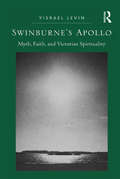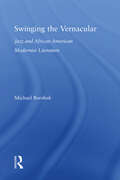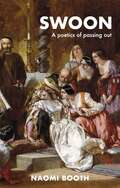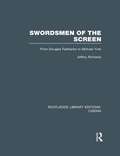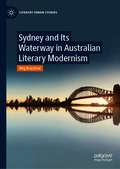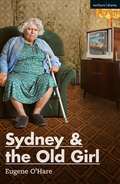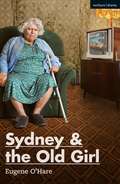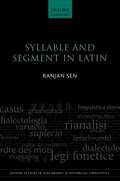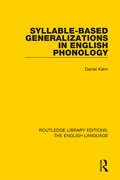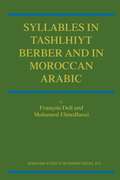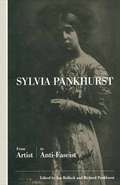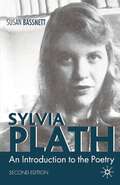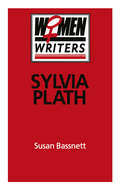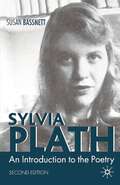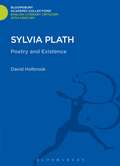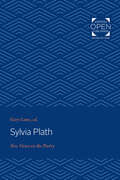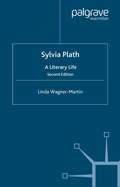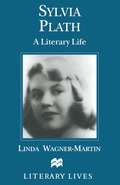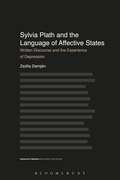- Table View
- List View
Swinburne's Apollo: Myth, Faith, and Victorian Spirituality
by Yisrael LevinFocusing on Algernon Charles Swinburne's poems on Apollo, Yisrael Levin calls for a re-examination of the poet's place in Victorian studies in light of his contributions to nineteenth-century intellectual history. Swinburne's Apollonian poetry, Levin argues, shows the poet's active participation in late-Victorian debates about the nature and function of faith in an age of changing religious attitudes. Levin traces the shifts that took place in Swinburne's conception of Apollo over a period of four decades, from Swinburne's attempt to define Apollo as an alternative to the Judeo-Christian deity to Swinburne's formation of a theological system revolving around Apollo and finally to the ways in which Swinburne's view of Apollo led to his agnostic view of spirituality. Even though Swinburne had lost his faith and rejected institutional religion by his early twenties, he retained a distinct interest in spiritual issues and paid careful attention to developments in religious thought. Levin persuasively shows that Swinburne was not simply a poet provocateur who enjoyed controversy but failed to provide valid cultural commentary, but was rather a profound thinker whose insights into nineteenth-century spirituality are expressed throughout his Apollonian poetry.
Swinburne's Apollo: Myth, Faith, and Victorian Spirituality
by Yisrael LevinFocusing on Algernon Charles Swinburne's poems on Apollo, Yisrael Levin calls for a re-examination of the poet's place in Victorian studies in light of his contributions to nineteenth-century intellectual history. Swinburne's Apollonian poetry, Levin argues, shows the poet's active participation in late-Victorian debates about the nature and function of faith in an age of changing religious attitudes. Levin traces the shifts that took place in Swinburne's conception of Apollo over a period of four decades, from Swinburne's attempt to define Apollo as an alternative to the Judeo-Christian deity to Swinburne's formation of a theological system revolving around Apollo and finally to the ways in which Swinburne's view of Apollo led to his agnostic view of spirituality. Even though Swinburne had lost his faith and rejected institutional religion by his early twenties, he retained a distinct interest in spiritual issues and paid careful attention to developments in religious thought. Levin persuasively shows that Swinburne was not simply a poet provocateur who enjoyed controversy but failed to provide valid cultural commentary, but was rather a profound thinker whose insights into nineteenth-century spirituality are expressed throughout his Apollonian poetry.
Swinging the Vernacular: Jazz and African American Modernist Literature
by Michael BorshukThis book looks at the influence of jazz on the development of African American modernist literature over the 20th century, with a particular attention to the social and aesthetic significance of stylistic changes in the music.
Swinging the Vernacular: Jazz and African American Modernist Literature
by Michael BorshukThis book looks at the influence of jazz on the development of African American modernist literature over the 20th century, with a particular attention to the social and aesthetic significance of stylistic changes in the music.
Swoon: A poetics of passing out
by Naomi BoothSwoon is the first extensive study of literary swooning, homing in on swooning’s rich history as well as its potential to provide new insights into the contemporary. This study demonstrates that passing-out has had a pivotal place in English literature. Beginning with an introduction to the swoon as a marker of aesthetic sensitivity, it includes chapters on swooning and generic transformation in Chaucer and Shakespeare; morbid, femininised swoons and excessive affect in romantic, gothic, and modernist works; irony, cliché and bathos in the swoons of contemporary romance fiction. This book revisits key texts to show that passing-out has been intimately connected to explorations of emotionality, ecstasy and transformation; to depictions of sickness and dying; and to performances of gender and gendering. Swoon offers an exciting new approach the history of the body alongside the history of literary response.
Swoon: A poetics of passing out
by Naomi BoothSwoon is the first extensive study of literary swooning, homing in on swooning’s rich history as well as its potential to provide new insights into the contemporary. This study demonstrates that passing-out has had a pivotal place in English literature. Beginning with an introduction to the swoon as a marker of aesthetic sensitivity, it includes chapters on swooning and generic transformation in Chaucer and Shakespeare; morbid, femininised swoons and excessive affect in romantic, gothic, and modernist works; irony, cliché and bathos in the swoons of contemporary romance fiction. This book revisits key texts to show that passing-out has been intimately connected to explorations of emotionality, ecstasy and transformation; to depictions of sickness and dying; and to performances of gender and gendering. Swoon offers an exciting new approach the history of the body alongside the history of literary response.
Swordsmen of the Screen: From Douglas Fairbanks to Michael York (Routledge Library Editions: Cinema)
by Jeffrey RichardsThis fascinating study of the genre of swashbuckling films received wide critical acclaim when it was first published in 1977. Jeffrey Richards assesses the contributions to the genre of directors, designers and fencing masters, as well as of the stars themselves, and devotes several chapters to the principal subjects if the swashbucklers – pirates, highwaymen, cavaliers and knights. The result is to recall, however fleetingly, the golden days of the silver screen. Reviews of the original edition: ‘An intelligent, scholarly, well-written account of adventure films, this work is sensitive both to cinema history and to the literary origins of the "swashbuckler"….Essential for any library with books on film, it may very well be the definitive book on its subject.’ – Library Journal
Swordsmen of the Screen: From Douglas Fairbanks to Michael York (Routledge Library Editions: Cinema)
by Jeffrey RichardsThis fascinating study of the genre of swashbuckling films received wide critical acclaim when it was first published in 1977. Jeffrey Richards assesses the contributions to the genre of directors, designers and fencing masters, as well as of the stars themselves, and devotes several chapters to the principal subjects if the swashbucklers – pirates, highwaymen, cavaliers and knights. The result is to recall, however fleetingly, the golden days of the silver screen. Reviews of the original edition: ‘An intelligent, scholarly, well-written account of adventure films, this work is sensitive both to cinema history and to the literary origins of the "swashbuckler"….Essential for any library with books on film, it may very well be the definitive book on its subject.’ – Library Journal
Sydney and Its Waterway in Australian Literary Modernism (Literary Urban Studies)
by Meg BrayshawThis book examines literary representations of Sydney and its waterway in the context of Australian modernism and modernity in the interwar period. Then as now, Sydney Harbour is both an ecological wonder and ladened with economic, cultural, historical and aesthetic significance for the city by its shores. In Australia’s earliest canon of urban fiction, writers including Christina Stead, Dymphna Cusack, Eleanor Dark, Kylie Tennant and M. Barnard Eldershaw explore the myth and the reality of the city ‘built on water’. Mapping Sydney via its watery and littoral places, these writers trace impacts of empire, commercial capitalism, global trade and technology on the city, while drawing on estuarine logics of flow and blockage, circulation and sedimentation to innovate modes of writing temporally, geographically and aesthetically specific to Sydney’s provincial modernity. Contributing to the growing field of oceanic or aqueous studies, Sydney and its Waterway and Australian Modernism shows the capacity of water and human-water relations to make both generative and disruptive contributions to urban topography and narrative topology
Sydney & the Old Girl (Modern Plays)
by Eugene O'HareLondon is becoming an alien landscape to Sydney Stock; a man who has lived for over fifty years cooped with his mother Nell in her grubby East End home. Theirs is a relationship of mutually assured destruction where the ghosts of the past continue to stalk and accuse. As the twisted game around family inheritance reaches breaking point, Irish care worker Marion Fee finds herself an unwitting pawn being played from both sides. At the centre of Eugene O'Hare's second full-length black comedy is a family's obsession with versions of the past and a paranoia about a future in a city which no longer feels like home.This edition was published to coincide with the world premiere at Park Theatre, London in November 2019.
Sydney & the Old Girl (Modern Plays)
by Eugene O'HareLondon is becoming an alien landscape to Sydney Stock; a man who has lived for over fifty years cooped with his mother Nell in her grubby East End home. Theirs is a relationship of mutually assured destruction where the ghosts of the past continue to stalk and accuse. As the twisted game around family inheritance reaches breaking point, Irish care worker Marion Fee finds herself an unwitting pawn being played from both sides. At the centre of Eugene O'Hare's second full-length black comedy is a family's obsession with versions of the past and a paranoia about a future in a city which no longer feels like home.This edition was published to coincide with the world premiere at Park Theatre, London in November 2019.
Syllable and Segment in Latin (Oxford Studies in Diachronic and Historical Linguistics #16)
by Ranjan SenSyllable and Segment in Latin offers new and detailed analyses of five long-standing problems in Latin historical phonology. In so doing, it clarifies the relative roles of synchronic phonological structure and phonetics in guiding sound change. While the phenomena can predominantly be explained by a reductionist view of diachronic phonology, claiming that demands of speech production and perception alone motivate and constrain historical development, the author shows that synchronic structure played the pivotal role of governing significant (but not immediately apparent) categorical and gradient surface variants, and that some phonetically explicable developments were in fact initiated and constrained by structural analogy. Ranjan Sen considers examines clear and dark /l/; inverse compensatory lengthening; syllabification before stop + liquid in vowel reduction; vocalic epenthesis in stop + /l/; and consonantal assimilations. He ascertains the phonological conditions for each phenomenon, reconstructs the motivations for the changes, and develops a methodology for the appropriate use of evidence from non-current languages to evaluate theories of diachronic phonology. He evaluates the likely phonetic and phonological influences by investigating studies across languages, establishing a secure evidence base through detailed philological examination, and reconstructing the phonetics - through both general principles and pertinent experimental studies - and the relevant phonological structure of the language. The book will appeal to graduate students and researchers in historical linguistics, phonology, Classical philology, and Indo-European linguistics.
Syllable-Based Generalizations in English Phonology (Routledge Library Editions: The English Language)
by Daniel KahnThis dissertation, first published in 1980, is concerned with the role of the syllable in generative grammar. Kahn argues that the syllable is a necessary element in phonological descriptions by identifying aspects of phonology that seem to call for analysis in terms of syllabic structure and demonstrating the superiority of syllabic analyses over possible alternative solutions. This title will be of interest to students of English language and linguistics.
Syllable-Based Generalizations in English Phonology (Routledge Library Editions: The English Language)
by Daniel KahnThis dissertation, first published in 1980, is concerned with the role of the syllable in generative grammar. Kahn argues that the syllable is a necessary element in phonological descriptions by identifying aspects of phonology that seem to call for analysis in terms of syllabic structure and demonstrating the superiority of syllabic analyses over possible alternative solutions. This title will be of interest to students of English language and linguistics.
Syllables In Tashlhiyt Berber And In Moroccan Arabic (International Handbooks of Linguistics #2)
by F. Dell M. ElmedlaouiThis book is intended primarily as an original contribution to the investi gation of the phonology of the two main languages spoken in Morocco. Its central topic is syllable structure. Our theoretical outlook is that of generative phonology. Most of the book deals with Tashlhiyt Berber. This language has a syllable structure with properties which are highly unusual, as seen from the vantage point of better-studied languages on which most theorizing about syllabification is based. On the one hand, complex consonant sequences are a common occurrence in the surface representations. On the other hand, syllable structure is very simple: only one distinctive feature bundle (phoneme) may occur in the onset, the nucleus or the coda. The way these two conflicting demands are reconciled is by allowing vowelless sylla bies . Any consonant may act as a syllable nucleus. When astring is syllabified, nuclear status is preferentially assigned to the segments with a higher degree of sonority than their neighbours. Consider for instance the expression below, which is a complete sentence meaning 'remove it (m) and eat it (m)': /kks=t t-ss-t=t/ [k. st. s . t:"] . k. k~t. t. s. . slt. The sentence must be pronounced voiceless throughout, as indicated by the IPA transcription between square brackets ; the syllabic parse given after the IPA transcription indicates that the sentence comprises four syllables (syllable nuclei are underlined). The differences between the dialects of Berber have to do primarily with the phonology and the lexicon.
Sylvia Pankhurst: From Artist to Anti-Fascist
by Ian BullockThis is the biography of Sylvia Pankhurst. A promising art student, she became involved in the Suffragette movement and was especially keen to take the cause to the East End of London. Much of her life was devoted to the causes of anti-fascism, anti-imperialism and the independence of Ethiopia.
Sylvia Plath: An Introduction to the Poetry
by Susan BassnettSylvia Plath is one of the best-known and most widely-studied writers of the twentieth century. Since her death in 1963, critics have presented different images of Plath: the 'suicidal' poet, the frustrated wife and mother, the feminist precursor.In this lively and approachable introduction to the author's poetry, Susan Bassnett offers a balanced view of Plath as one of the finest contemporary poets, and shows the diversity of her work. Bassnett's refreshing perspective on the writer provides a welcome alternative to the many studies which attempt endlessly to psychoanalyse Plath posthumously. Bassnett argues that there can never be any definitive version of the Plath story, but, from close readings of her texts, readers can discover the excitement of her diverse work. Plath is not viewed as an author driven by a death wish, nor does the book focus on her suicide - instead, she is considered in the cultural context in which she wrote, and viewed as a complex writer.Now thoroughly revised and expanded in the light of recent research, the second edition of this essential text contains new chapters and more close reading of the poetry. It concludes with an analysis of Ted Hughes' Birthday Letters, a collection of poems which he wrote about his wife after her death.
Sylvia Plath: An Introduction to the Poetry
by Susan BassnettSylvia Plath is one of the best-known and most widely-studied writers of the twentieth century. Since her death in 1963, critics have presented different images of Plath: the 'suicidal' poet, the frustrated wife and mother, the feminist precursor.In this lively and approachable introduction to the author's poetry, Susan Bassnett offers a balanced view of Plath as one of the finest contemporary poets, and shows the diversity of her work. Bassnett's refreshing perspective on the writer provides a welcome alternative to the many studies which attempt endlessly to psychoanalyse Plath posthumously. Bassnett argues that there can never be any definitive version of the Plath story, but, from close readings of her texts, readers can discover the excitement of her diverse work. Plath is not viewed as an author driven by a death wish, nor does the book focus on her suicide - instead, she is considered in the cultural context in which she wrote, and viewed as a complex writer.Now thoroughly revised and expanded in the light of recent research, the second edition of this essential text contains new chapters and more close reading of the poetry. It concludes with an analysis of Ted Hughes' Birthday Letters, a collection of poems which he wrote about his wife after her death.
Sylvia Plath: Poetry and Existence (Bloomsbury Academic Collections: English Literary Criticism)
by David HolbrookAdmirers of the work of Sylvia Plath will welcome this new paperback edition of a study, first published by The Athlone Press in 1976, which provides coherent and persuasive readings of her poetry. Drawing upon the traditional skills of the literary critic, David Holbrook also deploys the illumination of both psychoanalysis and phenomenology in a pioneering work of literary, individual and cultural interpretation.
Sylvia Plath: New Views on the Poetry
by Gary LaneOriginally published in 1979. Sylvia Plath is one of the most controversial poets of our time. For some readers, she is the symbol of women oppressed. For others, she is the triumphant victim of her own intensity—the poet pursuing sensation to the ultimate uncertainty, death. For still others, she is a doomed innocent whose sensibilities were too acute for the coarseness of our world. The new essays of this edited collection (with a single exception, all were written for this book) broaden the perspective of Plath criticism by going beyond the images of Plath as a cult figure to discuss Plath the poet. The contributors—among them Calvin Bedient, Hugh Kenner, J. D. O'Hara, and Marjorie Perloff—draw on material that most previous commentators lacked: a substantial body of Plath's poetry and prose, a moderately detailed biographical record, and an important selection of the poet's correspondence. The result is an important and provocative volume, one in which major critics offer an abundance of insights into the poet's mind and creative process. It offers insightful and original readings of many poems—some, like "Berck-Plage," scarcely mentioned in previous criticism—and fosters new understandings of such matters as Plath's comedy, the development of her poetic voice, and her relation to poetic traditions. The serious reader, whatever his or her initial opinion of Sylvia Plath, is sure to find that opinion challenged, changed, or deepened. These essays offer insights into a violently interesting poet, one who despite, or perhaps because of, her suicide at age thirty continues to fascinate and trouble us.
Sylvia Plath: A Literary Life (Literary Lives)
by L. Wagner-MartinSylvia Plath: A Literary Life examines the way Plath made herself into a writer. Close analysis of Plath's reading and apprenticeship writing both in fiction and poetry sheds considerable light on Plath's work in the late 1960s. In this updated edition there will be discussion of the aftermath of Plath's death including the publication of her Collected Poems edited by Ted Hughes which won the Pulitzer Prize for Poetry in 1982. Biographies of Plath will be examined along with the publication of Hughes's Birthday Letters . A chronology maps out key events and publications both in Plath's lifetime and posthumously.
Sylvia Plath: A Literary Life (Literary Lives)
by Linda Wagner-MartinLinda Wagner-Martin's emphasis in this study is the way Sylvia Plath made herself into a writer. In keeping with the critic's early ground-breaking work on American poet William Carlos Williams, she here studies elements of Plath's work with dedication to discussions of style and effect. Her close analysis of Plath's reading and her apprenticeship writing both in fiction and poetry sheds considerable light into Plath's work in the late 1960s. The book concludes with a section assessing Sylvia Plath's current standing.
Sylvia Plath and the Language of Affective States: Written Discourse and the Experience of Depression (Advances in Stylistics)
by Zsofia DemjenFocusing on the first journal in The Unabridged Journals of Sylvia Plath, this book writes a convincing case for the value of corpus-based stylistics and narrative psychology in the analysis of representations of the experience of affective states.Situated at the intersection between language study, psychology and healthcare, this study of the personal writing of a poet and novelist showcases a cutting-edge combination of quantitative and qualitative approaches, including metaphor analysis, corpus methods, and second person narration. Techniques that systematically account for representations of experiences of affective states, such as those in this book, are rare and crucial in improving understanding of these experiences. The findings and methods of this book therefore potentially have bearing on the study, diagnosis and treatment of depression and other mental illnesses. Zsófia Demjén follows the cognitive turn in both literary studies and linguistics here, emerging with a greater understanding of Plath, her diarized output and her experience of her inner world.
Sylvia Plath and the Language of Affective States: Written Discourse and the Experience of Depression (Advances in Stylistics)
by Zsofia DemjenFocusing on the first journal in The Unabridged Journals of Sylvia Plath, this book writes a convincing case for the value of corpus-based stylistics and narrative psychology in the analysis of representations of the experience of affective states.Situated at the intersection between language study, psychology and healthcare, this study of the personal writing of a poet and novelist showcases a cutting-edge combination of quantitative and qualitative approaches, including metaphor analysis, corpus methods, and second person narration. Techniques that systematically account for representations of experiences of affective states, such as those in this book, are rare and crucial in improving understanding of these experiences. The findings and methods of this book therefore potentially have bearing on the study, diagnosis and treatment of depression and other mental illnesses. Zsófia Demjén follows the cognitive turn in both literary studies and linguistics here, emerging with a greater understanding of Plath, her diarized output and her experience of her inner world.
